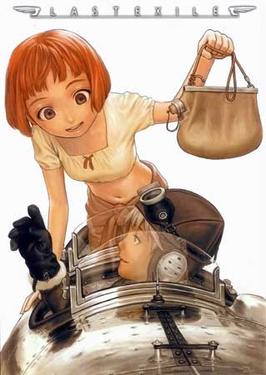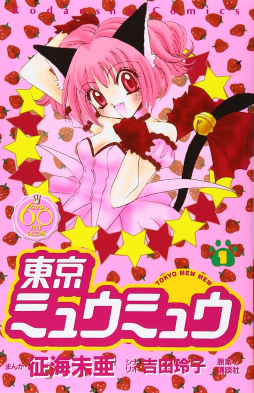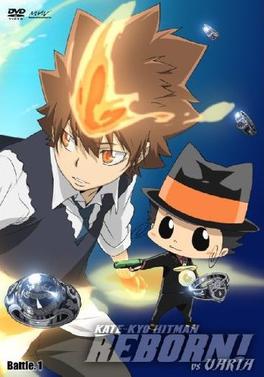Related Research Articles

Mobile Police Patlabor, also known as Patlabor, is a Japanese science fiction media franchise created by Headgear, a group consisting of manga artist Masami Yūki, director Mamoru Oshii, screenwriter Kazunori Itō, mecha designer Yutaka Izubuchi, and character designer Akemi Takada.

Last Exile is a Japanese anime television series created by Gonzo. It featured a production team led by director Koichi Chigira, character designer Range Murata, and production designer Mahiro Maeda. The three had previously worked together in Blue Submarine No. 6, one of the first CG anime series. It aired on TV Tokyo from April to September 2003. A sequel series, Last Exile -Fam, the Silver Wing-, aired from October 2011 to March 2012. A film adaptation of the series, Last Exile -Fam, the Silver Wing-: Over the Wishes, was released in February 2016.

Tokyo Mew Mew is a Japanese manga series created and written by Reiko Yoshida and illustrated by Mia Ikumi. It was originally serialized in Kodansha's shōjo manga magazine Nakayoshi from September 2000 to February 2003, with its chapters collected in seven tankōbon volumes by Kodansha. It focuses on five girls infused with the DNA of endangered animals which gives them special powers and allows them to transform into "Mew Mews". Led by Ichigo Momomiya, the girls protect Earth from aliens who wish to "reclaim" it.

Gunslinger Girl is a Japanese manga series written and illustrated by Yu Aida. It was serialized in Dengeki Daioh magazine from May 2002 to September 2012. Its chapters were collected in 15 tankōbon volumes by ASCII Media Works. Set in modern Italy, the series focuses on young cybernetic girls and their adult male handlers who use them as assassins under the directions of a government organization.

The Agent of the Soul Reaper Saga is the first season of the Bleach anime series. The episodes are directed by Noriyuki Abe, and produced by TV Tokyo, Dentsu and Studio Pierrot. In the English release by Viz Media, the title is changed to The Substitute. The season adapts the first eight volumes of Tite Kubo's Bleach manga series, spanning twenty episodes. The episodes' plot covers the adventures of Ichigo Kurosaki after becoming a Soul Reaper and assuming the duties of Soul Reaper Rukia Kuchiki.

The Soul Society: The Sneak Entry arc is the second season of the Bleach anime series, containing 21 episodes. The episodes are directed by Noriyuki Abe, and produced by TV Tokyo, Dentsu and Studio Pierrot. In the English release by Viz Media, the title is translated as The Entry. The season adapts Tite Kubo's Bleach manga series from the 9th volume to the 14th volume, with the exception of episode 33 (filler). The episodes' plot centers on Ichigo Kurosaki and his friends' journey to the Soul Society in order to save Soul Reaper Rukia Kuchiki from her impending execution.

The sixth season of the Bleach anime series is named the Arrancar: The Arrival arc. In the English adaptation of the anime released by Viz Media, the title of the season is translated as The Arrancar. The episodes are directed by Noriyuki Abe, and produced by TV Tokyo, Dentsu and Studio Pierrot. The season adapts Tite Kubo's Bleach manga series from the rest of the 21st volume to the 26th volume, with the exception of episodes 128–131 (filler). The episodes' plot centers on the burgeoning war between the Soul Reapers and the Arrancar led by former Soul Reaper captain Sōsuke Aizen.

Lupin the 3rd Part II, also known as Shin Lupin III or simply as Lupin III for the American market, is a Japanese anime series based on the manga by Monkey Punch and is produced by Tokyo Movie Shinsha. The first season, which contains 26 episodes, aired between October 3, 1977 and April 3, 1978 on NTV. The opening theme is Theme from Lupin III '77 by Yuji Ohno, while the ending theme is the instrumental version of Love Theme, also by Yuji Ohno. In the United States, twenty-six episodes of English adaptation of the series aired on Adult Swim starting on January 14, 2003 at midnight ET with the exception of episode 3, which was skipped due to its Nazi themes. In Canada, the entire first season of the series aired on G4techTV's Anime Current from May 7 to June 11, 2007.

One Piece is a Japanese anime television series produced by Toei Animation that premiered on Fuji Television in October 1999. It is based on Eiichiro Oda's manga series of the same name. The story follows the adventures of Monkey D. Luffy, a boy whose body gained the properties of rubber after unintentionally eating a Devil Fruit. With his crew, named the Straw Hat Pirates, Luffy explores the Grand Line in search of the world's ultimate treasure known as the "One Piece" in order to become the next King of the Pirates.

The second season of the Reborn! anime television series compiles episodes 34 through 65. The second season aired in Japan from June 2, 2007 to January 12, 2008 on TV Tokyo. Titled as Katekyō Hitman Reborn! in Japan, the Japanese television series was directed by Kenichi Imaizumi, and produced and animated by Artland. The plot, based on the Reborn! manga by Akira Amano, follows the life of Tsunayoshi "Tsuna" Sawada, the candidate to be the Mafia boss of the Vongola Famiglia, who must fight against a group of assassins called the Varia who wants to get their leader Xanxus to become the Vongola boss. In order to help Tsuna, some of his friends become guardians for the Vongola to fight the Varia.

The fourth season of the Reborn! anime television series compiles episodes 74 through 101, which aired in Japan from March 15, 2008 to September 27, 2008 on TV Tokyo. Titled as Katekyō Hitman Reborn! in Japan, the Japanese television series was directed by Kenichi Imaizumi, and produced and animated by Artland. The plot, based on the Reborn! manga by Akira Amano, follows how Tsunayoshi "Tsuna" Sawada, the candidate to be the Mafia boss of the Vongola Famiglia, and his friends are accidentally sent to the future nearly 10 years later. As they arrive, they discover that the Millefiore Mafia family has been annihilating the Vongola.

The fifth season of the Reborn! anime television series compiles episodes 102 through 140 that aired between October 4, 2008 and July 4, 2009 on TV Tokyo. Titled as Katekyō Hitman Reborn! in Japan, the Japanese television series is directed by Kenichi Imaizumi, and produced and animated by Artland. The plot, based on the Reborn! manga by Akira Amano, follows Tsunayoshi "Tsuna" Sawada, the future boss of the infamous Vongola Mafia family, and his friends after they are sent into the future. In this future, nearly ten years after their own time, they are faced with the Millefiore Family, a threat to the Vongola and the world. This season begins with the main characters invading a Millefiore base.

The first season of the Naruto anime television series is directed by Hayato Date, and produced by Pierrot and TV Tokyo. Based on Masashi Kishimoto's manga series, the season follows Naruto Uzumaki living in the Hidden Leaf Village, determined to become the next Hokage and gain the respect of the villagers. The first season ran from October 3, 2002, to May 28, 2003, on TV Tokyo and its affiliates.

The fourth season of the Naruto anime television series, labelled as the "4th Stage" in the Japanese DVD release, is directed by Hayato Date, and produced by Studio Pierrot and TV Tokyo. Based on Masashi Kishimoto's manga series, the season follows Naruto Uzumaki and his friends assigning on different short missions, after Sasuke Uchiha joins up with Orochimaru. The episodes aired in Japan from July 6, 2005, to May 3, 2006, on TV Tokyo.

Yu-Gi-Oh!, known in Japan as Yu-Gi-Oh! Duel Monsters and alternatively subtitled Rulers of the Duel in the United States and Canada, is a Japanese anime series animated by Studio Gallop based on the Yu-Gi-Oh! manga series written by Kazuki Takahashi. It is the second anime adaptation of the manga following the 1998 anime television series produced by Toei Animation. The series revolves around a young high school boy named Yugi Muto who battles opponents in the Duel Monsters card game. The series begins from chapter 60 in volume 7 before loosely adapting the remaining chapters of the original manga by making story changes that conflict with the events of the manga canon.